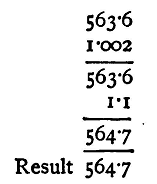| Practical Physics is a free textbook on basic laboratory physics. See the editorial for more information.... |

|

Home  Physical Arithmetic Physical Arithmetic  Arithmetical Manipulation of Approximate Values Arithmetical Manipulation of Approximate Values |
||||||






|
||||||
Arithmetical Manipulation of Approximate Values
In order to represent a quantity to the degree of accuracy of one part in a thousand, we require a number with four digits at most, exclusive of the zeros which serve to mark the position of the number in the decimal scale.1 It frequently happens that some arithmetical process, employed to deduce the required result from the observations, gives a number containing more than the four necessary digits. Thus, if we take seven observations of a quantity, each to three figures, and take the mean, we shall usually get any number of digits we please when we divide by the 7. Superfluous figures very frequently occur in the multiplication and division of approximate values of quantities. These have also to be discarded from the result; for if we multiply two numbers, each of which is accurate only to one part in a thousand, the result is evidently only accurate to the same degree, and hence all figures after the fourth must be discarded. The arithmetical manipulation may be performed by using logarithms, but it is sometimes practically shorter to work out the arithmetic than to use logarithms; and in this case the arithmetical process may be much abbreviated by discarding unnecessary figures in the course of the work. The following examples will show how this is managed: Example (1). - Multiply 656.3 by 4.321 to four figures.
The multiplication in the abbreviated form is conducted in the reverse order of the digits of the multiplier. Each successive digit of the multiplier begins at one figure further to the left of the multiplicand. The decimal point should be fixed when the multiplication by the first digit (the 4) is completed. To make sure of the result being accurate to the requisite number of places, the arithmetical calculation should be carried to one figure beyond the degree of accuracy ultimately required. Example (2). - Divide 65.63 by 4.391 to four figures.
In the abbreviated form, instead of performing the successive steps of the division by bringing down 0's, successive figures are cut off from the divisor, beginning at the right hand; thus, the divisors are for the first two figures of the quotient 4391; for the next figure, 439; for the next, 43. It can then be seen by inspection that the next figure is 8. The division is thus accomplished. It will be seen that one 0 is added to the dividend; the arithmetic is thus carried, as before, to one figure beyond the accuracy ultimately required. This may be avoided if we always multiply the divisor mentally for one figure beyond that which we actually use, in order to determine what number to 'carry'; the number carried appears in the work as an addition to the first digit in the multiplication. The method of abbreviation, which we have here sketched, is especially convenient for the application of small corrections (see below, p. 42). We have then, generally, to multiply a number by a factor differing but little from unity; let us take, for instance, the following: Example (3). - Multiply 563.6 by 1.002 to four places of decimals. Adopting the abbreviated method we get
or Example (4). - Multiply 563.6 by 0.9998. In this case 0.9998 = 1 - 0.0002.
It will be shown later (p. 44) that dividing by 0.9998 is the same, as far as the fourth place of decimals is concerned, as multiplying by 1.002, and vice versa; this suggests the possibility of considerable abbreviation of arithmetical calculation in this and similar cases.
|
||||||
Home  Physical Arithmetic Physical Arithmetic  Arithmetical Manipulation of Approximate Values Arithmetical Manipulation of Approximate Values |
||||||
Last Update: 2011-03-27





